The infographics of tyranny exposed in a new handbook

The infographic has a lot to answer for. Conceived as a means of conveying lots of data in an easily digestible format, it has evolved into a lazy substitute for meaningful content. At first glance, The Handbook of Tyranny is simply more of the same, a slim volume of maps, charts, graphs and diagrams that one presumes is a substitute for a more substantive discussion.
Created by the architect and designer Theo Deutinger, the Handbook should probably be subtitled ‘brief glimpses into our hideous world,’ for it brings home the worst aspects of modern life, rendering the banality of evil like a spreadsheet. With chapter headings like ‘Walls & Fences’, ‘Refugee Camps’ and ‘Crowd Control,’ you know you’re in for a deep dive into the structures and systems that control our world - some obvious, some not.
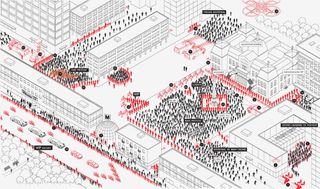
Infographic displaying how crowds are controlled during a protest, in real time
The breadth of information here is never less than fascinating. Discover which 14 countries ‘welcome every citizen from any country in the world with a valid passport without any visa restrictions,’ or the myriad designs for keeping people out (and in) of the world’s many contested and conflicted border zones.
This is a graphic project rich in hidden history and unsavoury elements. Aficionados of graphic design will be fascinated by the iconographic breakdown of the flags and logos of the world’s most notorious terrorist groups, from ETA to ISIL, but the shock value of a refugee camp map of Africa is much greater.
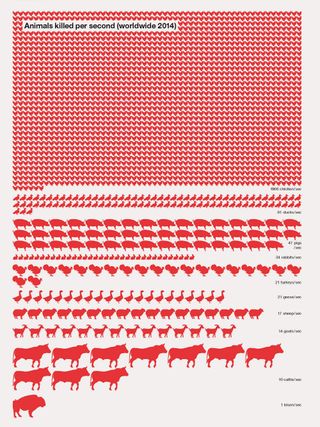
Infographic displaying how many animals are killed per second world wide
Of course, the two subjects are inextricably linked and that’s one of Deutinger’s main points – these are all systems and structures that have sprung up around the world to perpetuate cruelties and conflicts. They range from the everyday (the myriad ‘defensive’ designs that litter the city to deter the homeless, skateboarders, the suicidal terrorist etc) through to the deeply unpleasant (the ‘death penalty’ fold out double page is not for the faint-hearted).
After a depressing diagrammatic trudge through the planning, function and output of the world’s animal slaughterhouses, the reader finally reaches a small pocket of post-industrial paranoia/optimism (delete according to your outlook). Deutinger’s plans for a ‘Green Fortress’ are a slightly tongue-in-cheek proposal for the ardent eco-survivalist, keen to shut themselves away from the tyranny outside.
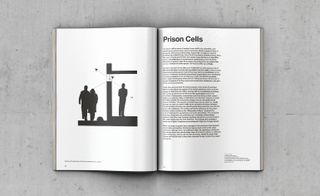
Infographic displaying the design of a prison cell, in which the window is placed at a height where people cannot see eye-to-eye
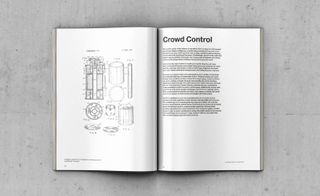
Illustration attached to a US patent for a tear gas grenade by Michael K. Levenson
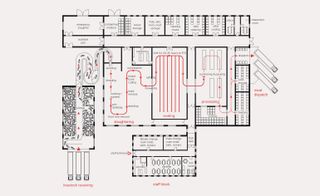
Floorplan of a slaughterhouse
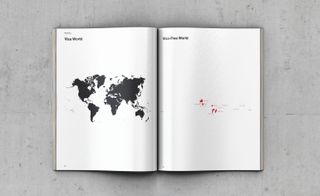
Infographic displaying the places in the world that you can enter without a visa (red), and those where a visa is required (black)

With chapter headings like ‘Walls & Fences’, ‘Refugee Camps’ (pictured) and ‘Crowd Control,’ you’re in for a deep dive into the structures and systems that control our world

Map of refugee camps around the world
INFORMATION
The Handbook of Tyranny, by Theo Deutinger. Published by Lars Muller Publishers, £25
Wallpaper* Newsletter
Receive our daily digest of inspiration, escapism and design stories from around the world direct to your inbox
Jonathan Bell has written for Wallpaper* magazine since 1999, covering everything from architecture and transport design to books, tech and graphic design. He is now the magazine’s Transport and Technology Editor. Jonathan has written and edited 15 books, including Concept Car Design, 21st Century House, and The New Modern House. He is also the host of Wallpaper’s first podcast.
-
 Why Bollinger’s La Grande Année 2015 champagne is worth celebrating
Why Bollinger’s La Grande Année 2015 champagne is worth celebratingChampagne Bollinger unveils La Grande Année 2015 and La Grande Année Rosé 2015, two outstanding cuvées from an exceptional year in wine-making
By Melina Keays Published
-
 Lexus installation explores time at Milan Design Week 2024
Lexus installation explores time at Milan Design Week 2024Lexus brought designer Hideki Yoshimoto’s ‘Beyond the Horizon’ to Milan’s Art Point, part of its ongoing series of collaborations with Fuorisalone
By Nargess Shahmanesh Banks Published
-
 Cult 1960s boutique Granny Takes A Trip gets a sustainable reboot
Cult 1960s boutique Granny Takes A Trip gets a sustainable rebootFounded on King’s Road in 1966, ‘radically creative’ fashion store Granny Takes A Trip is being reimagined for a new generation. Dal Chodha takes a closer look
By Dal Chodha Published
-
 Nilufar turns its Depot space into a pop-up bookshop
Nilufar turns its Depot space into a pop-up bookshopNilufar Depot in Milan opens Bookings, a pop-up bookshop within the design gallery
By Rosa Bertoli Last updated
-
 Jasper Morrison’s new chair for Molteni & C is a tribute to lightness
Jasper Morrison’s new chair for Molteni & C is a tribute to lightnessJasper Morrison’s new ‘Tea’ chair for Molteni & C is a refreshing take on traditional dining chairs
By Léa Teuscher Last updated
-
 What is an original? A new Bauhaus exhibition investigates
What is an original? A new Bauhaus exhibition investigatesBy Giovanna Dunmall Last updated
-
 Graphic tributes celebrate the Design Museum’s 30th anniversary
Graphic tributes celebrate the Design Museum’s 30th anniversaryPaul Smith, Nathalie du Pasquier, John Pawson and more have riffed on the number 30 in punchy new logos
By Jessica Mairs Last updated
-
 Spanish designers question the concept of a book in New York
Spanish designers question the concept of a book in New YorkBy Laura May Todd Last updated
-
 Amorepacific HQ signage by Sascha Lobe wins Wallpaper* Design Award
Amorepacific HQ signage by Sascha Lobe wins Wallpaper* Design AwardBy Jonathan Bell Last updated
-
 Sharjah gains a new graphic design biennial set inside a former 1970s abandoned bank
Sharjah gains a new graphic design biennial set inside a former 1970s abandoned bankBy Rosa Bertoli Last updated
-
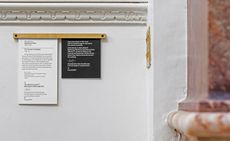 Graphic design studio LucienneRoberts+ reimagines the display system at the Royal Academy
Graphic design studio LucienneRoberts+ reimagines the display system at the Royal AcademyBy Charlotte Jansen Last updated